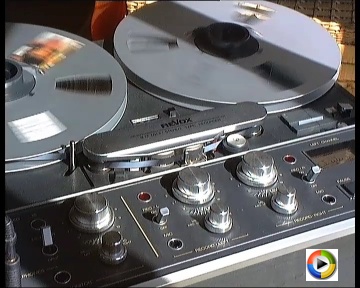WHO INVENTED THE MAGNETIC RECORDING ? THE HISTORY
Since the XVI century people tried many times to build a machine able to "remember" voice or music.
They must attend until 1877 when T.A. Edison invents the first really working record machine using a wax cylinder. Starting from this idea they will arrive steps by steps to the vinyl disc as we know it now.
The real magnetic recording born in 1898 due to the work of Danish technician inventor Valdemar Poulsen. Working on some telegraph accessories Poulsen invents the “Telegraphone” a record machine using a steel wire as magnetic support sliding in front of an electromagnet.
Poulsen Telegraphone 1915 approx.
Source: www.acmi.net.au
|
The
invention gains the first prize at the Expo of Paris in 1900 and
receive the patent in USA where Poulsen starts to produce dictating
machines and telephone recorders. Unfortunately, as often happens to
innovative inventions, the public does not well receive these new
products and in 1920 about the factory shot down and Poulsen leaves
his plans.
During the 1930 Germans engineers discover the Poulsen's invention and develop it for war purpose. Adolf Hitler trusts in the new machine potential and press to much for its improvement. Some year later with magnetic recorders he will transmit his propaganda speeches in different cities at the same time never being exactly localized by the enemy forces.
The major contribution from the engineers of AEG-TELEFUNKEN, the first electrical German factory (does this name remember something to you ?) to the magnetic recorder invention is changing the steel wire into a thin cellulose magnetic coated tape.
In 1934 BASF Company (now one of the biggest world wide chemical company which magnetic consumer product brand become EMTEC, later a brand of MPO group and actually RMGI) under request of AEG technicians produces the first magnetic tape on plastic support. Many great advantages has the plastic tape: it is lighter than the steel wire and not dangerous (steel wire is very loud and cutting as a razor blade), stronger than the cellulose tape (that broke very often) and above all it can be canceled and recorded many and many times.
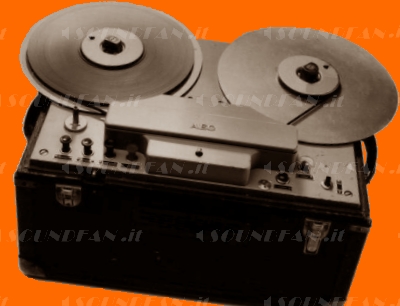 AEG Magnetophone 1934 |
In 1935
AEG perfects
definitively the “Magnetophone” and
they record the London Philarmonic Orchestra for the first time.
Later in 1940/41 AEG engineers Weber and Von Braunmuhl discover and apply the BIAS technique to magnetic recording improving the "Magnetophone" in the first “HiFi” tape recorder of the history. It is very close to the reel to reel recorders used later in many recording studios across the Europe someone still working today.
In 1945 at the World War II end the Americans and English technicians ignore the existing of magnetic tape recorders. They find some Magnetophones missing by the German around the occupied cities and begins to study them transferring in America the patents too. In this way the magnetic recorder is “re-discovered” again.
In 1946 the AMPEX Company, by Alexander M. Poniatoff and Jack Mullin (the technician charged to study the “Magnetophone”), starts to produce the first magnetic recorders for Government use only. The importance of magnetic recorders became evident very soon for the musical and cinema industry too. At the same time the 3M Company (the "Scotch" Company) starts to produce magnetic tapes on plastic support.
In 1947 with 3M's SCOTCH 100 tape the American tape industry starts the business on large scale.
On April 25 1948 takes place the first commercial recording of the “Bing Crosby Show” by Jack Mullin using an AMPEX MODEL 200 for a delayed radio broadcast. Mr. Bing Crosby will give a big impulse to Ampex development becoming the major investor of the company.
The game is done. The modern era of magnetic recording is born.
The main problem is tape recorders are too large and heavy, it is very difficult to use them in live recording because they have to be carried by trucks and need fixed high power supply.
In 1949 a Swiss guy Mr. Willi Studer after some study produces the first compact recorder that still needs mains power anyway.
In 1951 the Studer Company divides in two brands: STUDER produces professional studios machines and REVOX produces semi professional and audio amateur (not really consumer) recorders. The magnetic recording is available now on large scale for many people. Later the Revox A77 and B77 reel to reel recorders will be built in many hundred thousands pieces and sell all around the world.
Later in 1940/41 AEG engineers Weber and Von Braunmuhl discover and apply the BIAS technique to magnetic recording improving the "Magnetophone" in the first “HiFi” tape recorder of the history. It is very close to the reel to reel recorders used later in many recording studios across the Europe someone still working today.
In 1945 at the World War II end the Americans and English technicians ignore the existing of magnetic tape recorders. They find some Magnetophones missing by the German around the occupied cities and begins to study them transferring in America the patents too. In this way the magnetic recorder is “re-discovered” again.
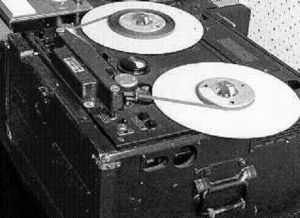 Magnetophone 1945
Source: www.acmi.net.au
|
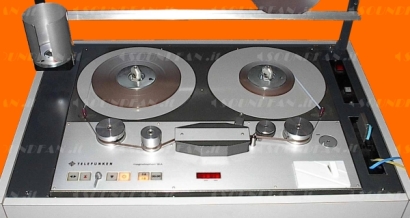 One of mine Telefunken Magnetophon M15A studio recorder. 1980ca. |
In 1946 the AMPEX Company, by Alexander M. Poniatoff and Jack Mullin (the technician charged to study the “Magnetophone”), starts to produce the first magnetic recorders for Government use only. The importance of magnetic recorders became evident very soon for the musical and cinema industry too. At the same time the 3M Company (the "Scotch" Company) starts to produce magnetic tapes on plastic support.
In 1947 with 3M's SCOTCH 100 tape the American tape industry starts the business on large scale.
On April 25 1948 takes place the first commercial recording of the “Bing Crosby Show” by Jack Mullin using an AMPEX MODEL 200 for a delayed radio broadcast. Mr. Bing Crosby will give a big impulse to Ampex development becoming the major investor of the company.
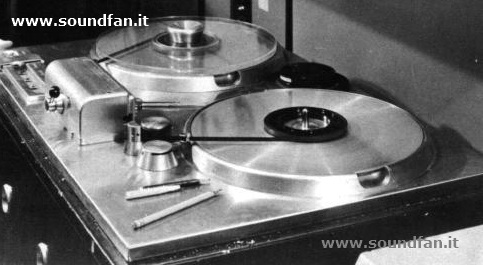 AMPEX 200 Source: Ampex Virtual Museum |
The game is done. The modern era of magnetic recording is born.
The main problem is tape recorders are too large and heavy, it is very difficult to use them in live recording because they have to be carried by trucks and need fixed high power supply.
In 1949 a Swiss guy Mr. Willi Studer after some study produces the first compact recorder that still needs mains power anyway.
In 1951 the Studer Company divides in two brands: STUDER produces professional studios machines and REVOX produces semi professional and audio amateur (not really consumer) recorders. The magnetic recording is available now on large scale for many people. Later the Revox A77 and B77 reel to reel recorders will be built in many hundred thousands pieces and sell all around the world.
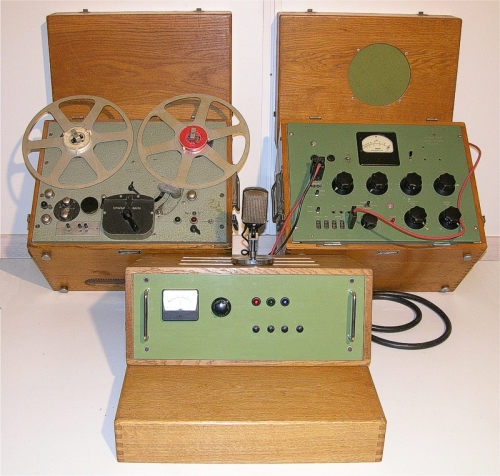 Studer A27. The first Studer
professional studio recorder.
source:www.algatronic-audiotech.ch
|
In 1951 another Swiss people Mr. Stefan Kudelsky, still student, build at home by himself the first prototype of the NAGRA I a light, small, professional, fully portable recorder that will became the absolute reference in radio, television, cinema and newspaper reporters fields. It will be used in every condition and different situation from the conquest of the Everest to the space missions. More than one million pieces have been built and it is produced up today.
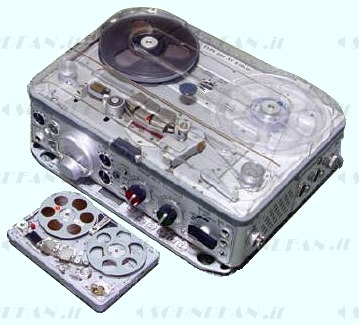
Nagra IV-S and the incredible
mini sized SNN for spying use
|
In 1955 the first multitrack commercial recorder is produced by Ampex Company based on the invention and later improvements of the multitrack recording system by Mr. Les Paul (yes, the producer of the world-wide famous guitar Gibson Les Pauls).
In 1955 the first STEREO prerecorded tapes are on the marked. The “Golden Age” of musical recording starts (with a stunning quality and musicality still stay today in many cases).
In 1964 The Royal Philips Company introduces the Compact Cassette recorder (the famous "K 7"), a portable cheap low-fi tape recorder using a small cartridge that will be the most used consumer magnetic tape in the next years.
In 1967 The Beatles record the famous album “Stg. Pepper” at Abbey Road Studio using two 4 tracks Studer J37.
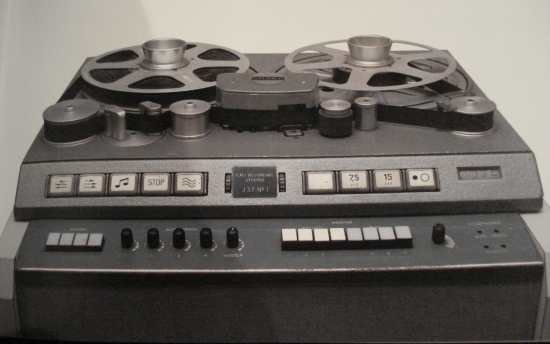 Studer
J37 No. 1 EMI Abbey Road Studios.
Note non standardized yet graphic symbols on the keyboard and the label "J37 No. 1". |
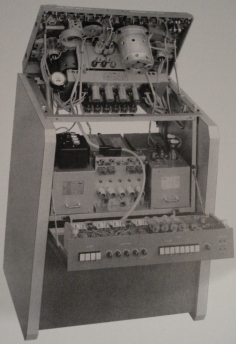 J37 Inside. On
top the impressive super sized capstan motor.
Source: as previous photo
|
Tape recorders have great
importance for the disc industry allowing delayed multi track recording
(the worldwide famous Tubular
Bells LP by Mike Oldfield recorded in 1973 onto a 16
tracks Ampex machine is the biggest example of this technique) and tape editing (the
"physical" cut and paste of the tape) giving endless possibility to the
musicians and sound engineers.
More than words this (crazy) video clip shows the use of tape editing. Turn your pc audio on and have fun !
Starting from the end of '80ties, reel to reel analog recorders are replaced more and more quickly by digital tape recorders and these last years by hard disk recorders (did you ever think an hard disk is a mini sized magnetic recorder at last ???). Some glorious firm as AMPEX or TELEFUNKEN closed; other ones as Studer, Revox or Nagra have deep company changes and reconvert in new technologies.
Fortunately there are many reel to reel analog tape recorders around the world full of fascination and never ending musicality and a lot of superior quality tapes and master tape to listen to.
Till today some (clever) recording studios and (good) musicians searching for high quality natural sound produce their masters with analog reel to reel recorders.
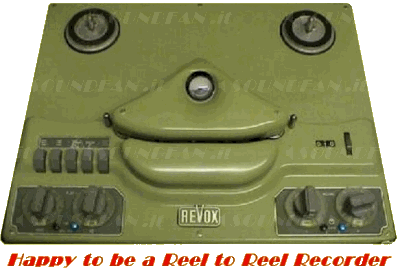
More than words this (crazy) video clip shows the use of tape editing. Turn your pc audio on and have fun !
Starting from the end of '80ties, reel to reel analog recorders are replaced more and more quickly by digital tape recorders and these last years by hard disk recorders (did you ever think an hard disk is a mini sized magnetic recorder at last ???). Some glorious firm as AMPEX or TELEFUNKEN closed; other ones as Studer, Revox or Nagra have deep company changes and reconvert in new technologies.
Fortunately there are many reel to reel analog tape recorders around the world full of fascination and never ending musicality and a lot of superior quality tapes and master tape to listen to.
Till today some (clever) recording studios and (good) musicians searching for high quality natural sound produce their masters with analog reel to reel recorders.
Reel
to reel recorders are still alive and kicking !

Revox D36


All rights reserved. © 2007 - 2015 Cesare Marchesini. Legal statement, sources, contents reproduction: please refer to the home page









